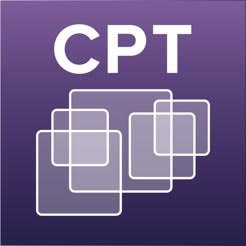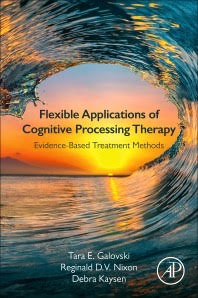

This is considered the gold-standard treatment manual for Cognitive Processing Therapy. This web course was created following the principles and techniques outlined within, but the book contains more detailed information and nuance that is difficult to convey in an online format. Purchasers of the manual will find a link that the publisher provides to download ALL the required worksheets for CPT.

CPTWeb2.0 learners might also be interested in providing their patients with a mobile smart-device app that increases the convenience of working through Cognitive Processing Therapy. The app contains modified versions of worksheets, patient learning modules, symptom tracking functionality, and notifications/reminders for therapy appointments. CPT Coach is not a “self-help” app, but a companion to therapy with a mental health provider.
CPT Coach is available in both the Apple App Store and the Google Play Store

This resource is highly recommended for those learners who may already have some familiarity with CPT, or who would like more advanced guidance about applying the treatment with complex patient presentations.
This volume is also available from Amazon and Barnes and Noble

Finally, if you would like to learn about:
you can find information about all of those possibilities at CPTforPTSD, which is the official CPT administration website maintained by the treatment developers. Although the treatment developers worked closely with the CPTWeb2.0 team to create this learning course, the workshop training, consultation, and provider verification process are all managed through that site.
![]()
As you will note throughout the course, monitoring the patient’s symptoms over the course of treatment is important. There are several measures that could be used for this task, but among the briefest and simplest is the “PCL” – PTSD Checklist. This document is available for free and includes both the checklist itself and simple instructions for scoring. As noted on the document, it was developed by our colleagues at the National Center for PTSD.
While CPT has been developed for individuals with at least average reading and writing abilities, aspects of it can be modified to be appropriate for those with literacy or learning difficulties. For example, you may simplify the terms throughout the therapy (e.g., using examples rather than the terms assimilation and accommodation). In addition, patients with learning difficulties will typically require more in-session practice of ABC Worksheets and other written practice assignments. You might encourage these patients to focus on two or three of the challenging questions and patterns of problematic thinking rather than trying to understand and apply all of them.
Finally, the simplified Challenging Questions and Challenging Beliefs Worksheet can be utilized and explained through repeated examples, with your support and patience. After attempting to work with the Simplified Challenging Beliefs Worksheet with little or no success, you may choose to use the Enhanced ABC Worksheets instead, emphasizing the questions at the bottom of the page regarding identifying alternative thoughts.
It is important, first of all, to make sure that the patient understands the purpose and the intent of the PCL, and other, measures. It is not uncommon for patients to come into the session angry with the world and consequently endorse items at a high level in the moment. Education about the measure prior to its introduction is key to getting an accurate reading of PTSD symptoms. Another factor that may explain high ratings can be that the patient is still processing the trauma or Stuck Points around the trauma(s). Some people can be “late bloomers” and still working on assimilated well after session 4. One way to determine what is happening, is to look at the items with a high endorsement rating and ask the patient what they were thinking about when they answered that question. Often there are stuck points behind that item to be addressed further. If a patients scores are going down, they should be praised for all of their work and accomplishments.
This can mean that the patient has more issues to continue to work on. Just as some patients are “done” early, there are some who need more processing. Make sure you look for assimilated stuck points that have not been resolved, especially related to traumas you may not have discussed in treatment. You can offer more up to 3 more individual sessions with a focus on Stuck Points that have not been resolved and keeping in mind that this does not become a never-ending therapy. Ultimately, there will be some people who will not benefit from CPT just as they might not for other therapies. Discuss with the patient what the best next step might be if they need something other than CPT.
The traditional way of doing CPT has been as a set 12 sessions, which is how this online course is structured. In our CPT research, this is how the treatment has typically been conducted. However, in 2012 a study (Galovski, et al. – see the Research tab under the Foundations module) determined that more than half (58%) of the study participants achieved a low score on PTSD and depression (and no longer met diagnostic criteria for PTSD) before 12 sessions. Furthermore, a bit over a quarter of the participants needed more than 12 sessions and reached a good end state by 18 sessions. If you are considering implementing variable length CPT, you should say before you start treatment that the therapy can vary between 5-20 sessions (or whatever upper limit you are allowed to have) depending on several factors: regular session attendance, completion of practice assignments, and a willingness to work hard to challenge and change beliefs.
If you are giving the PCL-5 scale weekly, the general cut-off for having PTSD is a score of 33. For a good end-state, a score below 20 is used. If someone has a score below 20, you could have a discussion about whether the patient is feeling good enough to stop treatment, or whether they want to continue for a few more sessions. If you are graphing PCL-5 scores (and you should be!), you can show on the graph that they are below the cut-off for PTSD, and you can point out that they act and look differently, as well as talk differently about their traumas. The decision whether to stop or continue should be up to the patient, but if they are afraid to stop, even though they are doing well, there may be a stuck point about leaving therapy. You can assign the patient to complete a Challenging Beliefs Worksheet about what will happen if they stop therapy. If the patient agrees that they are ready to stop, you should conduct one more session. You should go over the Stuck Point Log to see if there are any remaining Stuck Points for them to focus on, go over the modules, or remaining modules, to see if their should be a focus on any of them. Give the patient any modules that they don’t have to look through and complete worksheets on. They should also be asked to write the final Impact Statement to review at the last session.
If the patient you are working with is not improving significantly (10 points on the PCL-5 is a clinically significant improvement) by halfway through the therapy, you should consider the possibility that you may not get to a good end state by 12 sessions. You could review the PCL-5 and, at the symptom level, ask what they are avoiding, or what they have nightmares or flashbacks about. That could lead you to important Stuck Points. Also check the Stuck Point Log to see if there is some particular lynchpin Stuck Point or core belief that is keeping the patient stuck, if they are not doing their practice assignments, or avoiding in other ways.
If the patient seems particularly stuck, especially later in therapy, you may consider talking to the patient about adding a few more sessions beyond 12. There are no new materials after the 12th session. The patient just uses the Challenging Beliefs Worksheet and works with the stuck points that remain on the log (or you have added to the log). The therapy should not go on endlessly, and the first 12 sessions should be conducted just the same as usual (unless there is a true emergency that you need to have an emergency session for- and then return to the protocol). If the patient is not participating in the therapy, it would be better to terminate for the time being or refer to someone else than to conduct the therapy poorly. If the patient achieves a good end score and is ready to stop after a few more sessions, you and the patient should discuss whether the next session will be the last one. If so, review the Stuck Point Log for any last worksheets to complete and assign the final Impact Statement. Conduct the final session as described in Session 12 module.